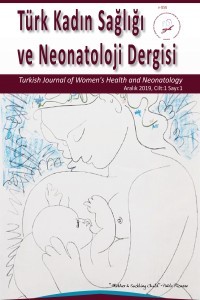Obstetrik Brakial Pleksus Felci
Yenidoğan Brakial Pleksus Felci, Periferik sinirler, Epidemiyoloji, Cerrahi
___
- Foad SL, Mehlman CT, Ying J. The epidemiology of neonatal brachial plexus palsy in the United States. J Bone Joint Surg 2008; 90A:1258–1264.
- Smellie W. A collection of cases and observation in midwifery to illustrate his former treatise or first volume on that subject. London: W Strahan, T Cadell, G Nico; 1779. p. 446–448.
- Duchenne GBA. De l’électrisation localisée et de son application a la pathologie et la therapeutique. Paris: J.B. Balleére et fils; 1872. p. 357–362.
- Erb W. Ueber eine eigenthümliche Localisation von Lähumgen implexus brachialis. Verhandlungen des naturhistorischen Vereins von Heidelberg 1874; 2:130–137.
- Klumpke A. Contribution a l’étude des paralysies radiculaires du plexus branchial. Rev Med 1885; 5:591–616.
- Kennedy R. SUTURE of the Brachial plexus in birth paralisis of the upper extremity. Br Med J. 1903; 1 (2197):298-301.
- Sever JW. Obstetric paralysis: Report of eleven hundred cases. JAMA 1925; 85:1862-1865.
- Gilbert A, Khouri N, Carlioz H. Birth palsy of the brachial plexus: Surgical exploration and attempted repairs in twenty one cases (in French). Rev Chir Orthop Reparatrice Appear Mot 1980; 66:33.
- Kattan AE, Borschel GH. Anatomy of the brachial plexus. J Pediatr Rehabil Med 2011; 4:107-111.
- Yücetürk A. Obstetrik Brachial Pleksus Yaralanmaları. Türk Ortopedi ve Travmatoloji Birliği Derneği Dergisi 2001(1); 24-35,27, 29-32.
- Doumouchtsis SK, Arulkumaran S. Are all brachial plexus injuries caused by shoulder dystocia? Obstet Gynecol Survey 2009; 64: 615-623.
- The American College of Obstetricians and Gynecologists Task Force on Neonatal Brachial Plexus Palsy. Risk and predictive factors. In: Neonatal Brachial Plexus Palsy, Washington, D.C. 2014. p.15.
- Evans-Jones G, Kay SP, Weindling AM, et al. Congenital brachial palsy: Incidence, causes, and outcome in the United Kingdom and Republic of Ireland. Arch Dis Child Fetal Neonatal Ed. 2003;88:F185–F189.
- Bilgin S, Altay M, Adıyaman S, Demirtaş M. Doğumsal brakial pleksus felci tedavisinde primer sinir cerrahisinin yeri. T Klin Tıp Bilimleri 2003; 23:174-179
- Al-Qattan MM. Obstetric brachial plexus palsy associated with breech delivery. Ann Plast Surg. 2003;51:257-264.
- Boyd ME, Usher RH, McLean FH. Fetal macrosomia: prediction risks, proposed management. Obstet Gynecol 1983; 61:715-22.
- Abid A. Brachial plexus birth palsy: Management during the first year of life Orthopedics Traumatology: Surgery Resaurch Vol 102,issue1, supplement, February 2016, Pages S125-S132
- Sunderland S. A classification of peripheral nerve injuries producing loss of function. Brain 1951; 74:491-516.
- Zafeiriou, DI, Psychogiou K. Obstetrical brachial plexus palsy. Pediatr Neurology 2008; 38:235-242.
- Al-Qattan, MM, El-Sayed AA, Al-Zahrani AY, et al. Narakas classification of obstetric brachial plexus palsy revisited. J Hand Surg Eur 2009; 34:788-791.
- Greenwald AG, Schute PC, Shiveley JL. Brachial plexus birth palsy: a 10-year report on the incidence and prognosis. J Pediatr Orthop 1984; 4:689-692.
- Hoeksma AF, Ter Steeg AM, Nelissen RG, van Ouwerkerk WJ, Lankhorst GJ, de Jong BA. Neurological recovery in obstetric brachial plexus injuries: an historical cohort study. Dev Med Child Neurol 2004; 46:76-83.
- Gilbert A, Brockman R, Carlioz H. Surgical treatment of brachial plexus birth palsy. Clin Orthop Relat Res 1991; 264:39-47.
- Dimitrios IZ, Psychogiou K. Obstetrical Brachial Plexus Palsy. Pediatr Neurol 2008; 38:235-242.
- Terzis JK, Kokkalis ZT. Pediatric Brachial Plexus Reconstruction Plast Reconstr Surg 2009; 124:370e.
- Gilbert A, Givato T, Kherialla T. Long-term Results of Primary Repair of Brachial Plexus Lesions in Children Microsurgery 2006; 26:334-342.
- Gonik B, McCormick EM, Verweij BH, Rossman KM, Nigro MA. The timing of congenital brachial plexus injury: a study of electromyography findings in the newborn piglet. Am J Obstet Gynecol 1998; 178:688-95.
- Heise CO, Siqueira MG, Martins RS, Gherpelli JLD. Clinical-electromyography correlation in infants with obstetric brachial plexopathy. J Hand Surg Am 2007; 32:999-1004.
- Waters PM. Update on management of pediatric brachial plexus palsy. J Pediatr Orthop B. 2005; 14:233-244.
- Clarke HM, Curtis CG. An approach to obstetrical brachial plexus injuries. Hand Clin 1995; 11:563e580.
- Başlangıç: 2019
- Yayıncı: Sağlık Bilimleri Üniversitesi Etlik Zübeyde Hanım Kadın Hastalıkları Eğitim ve Araştırma Hastanesi
Sezin ERTÜRK AKSAKAL, Derya AKDAG CİRİK, Tuğba ALTUN ENSARİ, Bora ÇOŞKUN, Gönül AKSU, Leyla MOLLAMAHMUTOĞLU, Ömer Lütfi TAPISIZ
Epizyotomi skarında gelişen endometriozis: Olgu sunumu
Recep ERİN, Yeşim BAYOĞLU TEKİN, Kübra BAKİ ERİN, Deniz KULAKSIZ
Operasyon öncesi doğru bir şekilde tanı konulan primer ovaryan gebelik
Özde SAKARYA, Derya ERDOĞAN, Hakan AYTAN
Mikroorganizmalar mavi gezegende bizden çok önce vardı: Pandemiler tarihi
Ömer Lütfi TAPISIZ, Sadiman KİYKAC ALTİNBAS
Obstetrik Brakial Pleksus Felci
Seyyid Şerif ÜNSAL, Mehmet ARMANGİL
Jinekolojik onkolojide tümör sarılı abdominal üreter için üreteral stent kullanımı
İlker SELCUK, Burak ERSAK, Atahan TOYRAN, Yalçın KIZILKAN, Hakan Raşit YALÇIN, Bülent ÖZDAL
Adölesan gebelikler ve yasal boyutu
Satı GÜL KAPISIZ, Zübeyir DEDEOĞLU
Düşük riskli hastada sezaryen sonrası vulvar tromboflebit: Olgu sunumu
